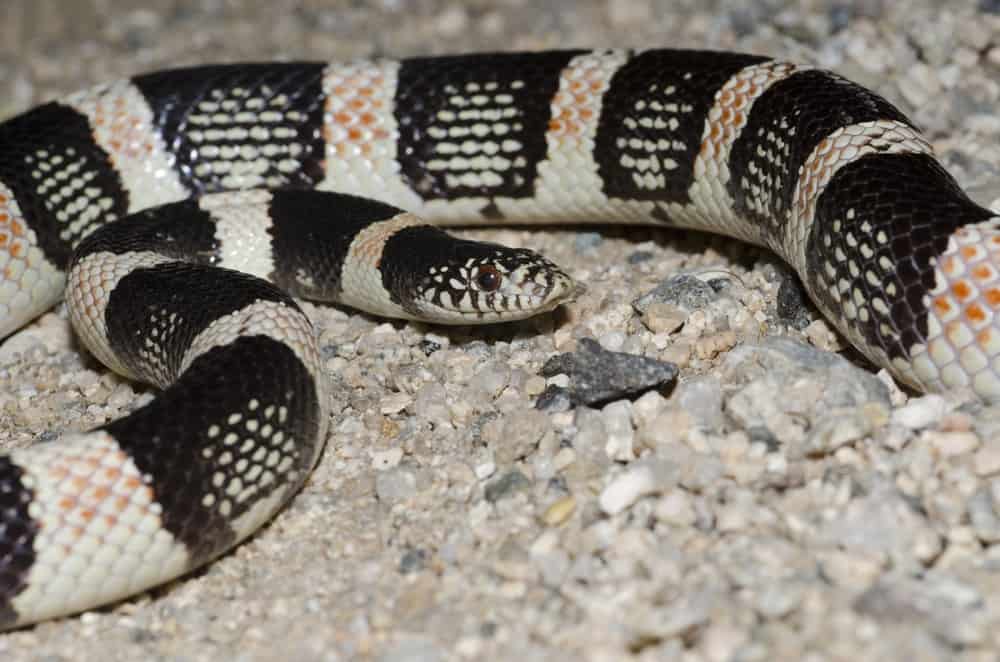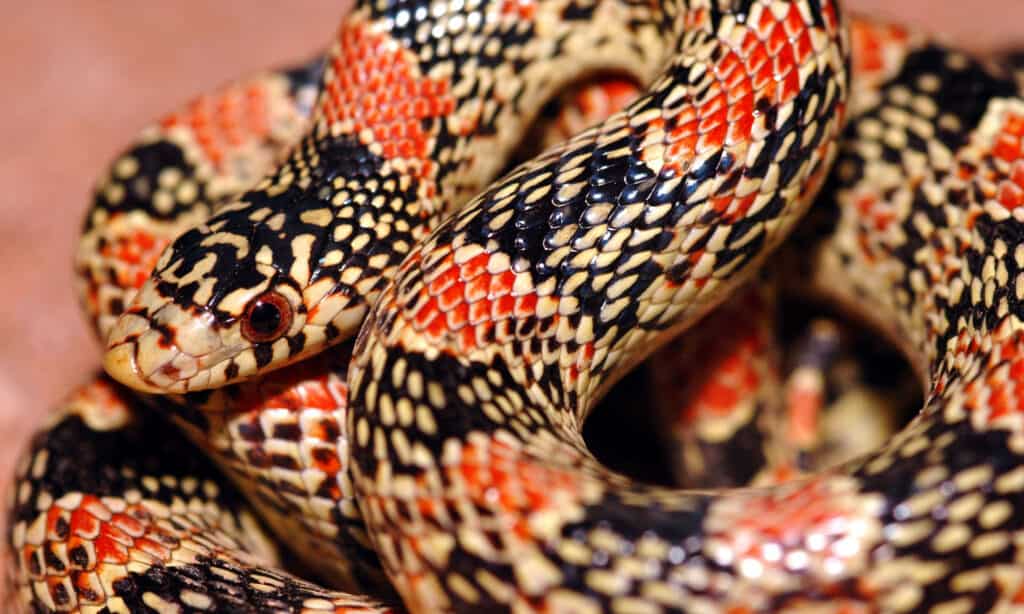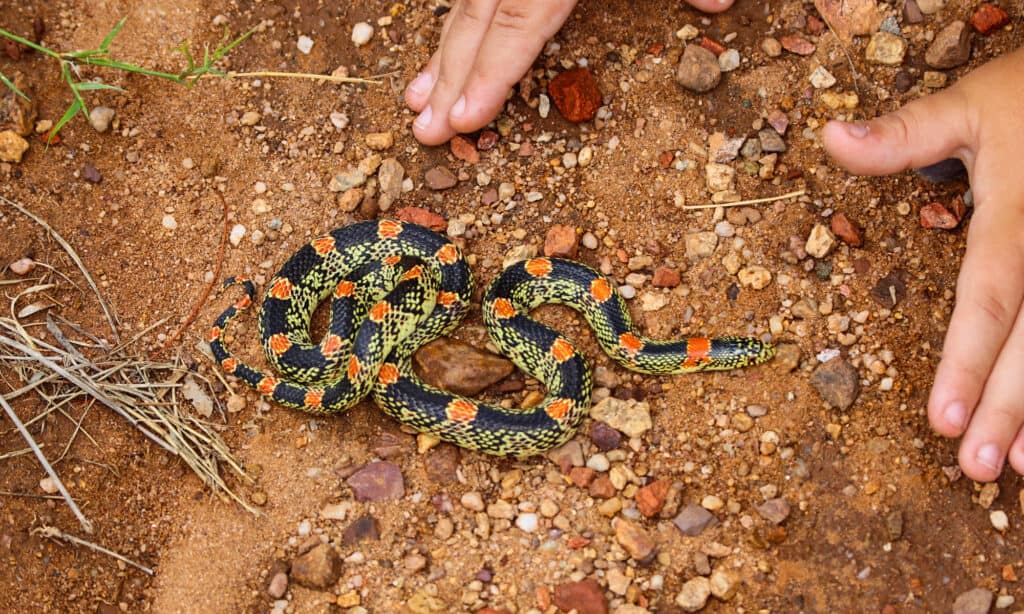Snakes are some of the most feared animals on the planet, and rightfully so. However, not all snakes are as scary as they seem; some are harmless. Of all the 3000 species of snakes in the world, except Antarctica, there are more non-venomous snakes than venomous.
However, because it is difficult to tell whether or not a snake is venomous at first glance, it is advisable to keep a reasonable distance from them until you are sure.
Of all the non-venomous snakes in the world, long-nosed snakes are some of the most unique and intriguing species. There are several reasons for this, but the most common one is their slightly upturned snout which is the origin of their name.
Keep reading to discover why this species is unique and the largest longnose snake ever recorded.
How To Identify Longnose Snakes

Unlike other non-venomous snakes in the United States, longnose snakes have undivided subcaudal scales
©Jason Mintzer/Shutterstock.com
Longnose snakes (Rhinocheilus lecontei) are a species of non-venomous snakes in the genus Rhinocheilus, the order Squamata, and the family of Colubridae, the largest snake family with over 300 unique genera. Easily recognized by their alternating black and orangish-red bands speckled with cream dots, longnose snakes are endemic to North America.
Apart from their upturned snouts, longnose snakes are easily identified by their cream or yellowish belly. Also, longnose snakes are popular in many parts of North America. However, they are not as well known as other species because they are commonly mistaken for California kingsnakes.
The main distinction between the two species is that California kingsnakes can be found in the wild in a variety of color morphs, typically with alternating dark and light bands that range in hue from black and white to brown and cream.
The majority of the caudal scales of longnose snakes are arranged in a single row, whereas the scales of kingsnakes are in two rows. Additionally, the California kingsnake is significantly larger, and its bands are more triangular than circular. The head is short, flattened, and has unique markings.
Also, unlike other non-venomous snakes in the United States, longnose snakes have undivided subcaudal scales. This species also has four other subspecies; the Isla Cerralvo long-nosed snake (Rhinocheilus lecontei etheridgei), the western long-nosed snake (Rhinocheilus lecontei lecontei), the Texas long-nosed snake (Rhinocheilus lecontei tessellatus), and lastly, the Mexican long-nosed snake (Rhinocheilus lecontei antonii).
What is The Largest Longnose Snake Ever Recorded?

The largest longnose snake ever recorded was about 41 inches long.
©Rusty Dodson/Shutterstock.com
Longnose snakes are relatively small. The total length of an adult longnose snake, including the tail, is around 22 to 32 inches (56 to 81 cm). The largest longnose snake ever recorded was about 41 inches (100 cm) long.
Where Can Longnose Snakes Be Found?
Longnose snakes can be extensively found in the southwestern parts of the United States of America and Mexico. They can be found in several places like southwestern Kansas, Idaho, Texas, Nevada, Arizona, Oklahoma, southeastern Colorado, and northern Mexico, from Chihuahua to San Luis Potos.
The preferred habitats of longnose snakes include grasslands, deserts, savannas, shrublands, etc. Due to their preference for rocky or dry environments over densely forested ones, they are rarely found in oak-hackberry forests. These snakes’ natural habitat is primarily found in tropical areas with elevations beneath 5400 feet (1645.9 m).
What Do Longnose Snakes Eat?

The diet of longnose snakes consists of amphibians, lizard eggs, lizards, and tiny snakes.
©Matt Jeppson/Shutterstock.com
Longnose snakes are carnivorous. The long-nosed snake eats both amphibians and reptiles. The diet primarily consists of amphibians, lizard eggs, lizards including Texas horned lizards, and tiny snakes. However, they do not prey on rodents as much as other snakes. Because longnose snakes are not venomous and cannot paralyze their prey, they swallow their prey whole.
One important thing to note is that longnose snakes are nocturnal creatures. During the day, they spend most of their time underground, unnoticed. These snakes enjoy digging burrows and only come out at night to look for food. As such, the chances of running into a longnose snake during the day are really low. However, at night, longnose snakes are very active and spend most of their time hunting.
How Do Longnose Snakes Reproduce?
Longnose snakes are oviparous. The female builds its nest inside holes or burrows in the earth during the early summer when she lays anywhere between four and nine eggs. The majority of the nests are constructed on well-aerated, damp, and loose soils.
Between August and September, the snakelets emerge. When a snakelet hatches from its eggs by chewing off the eggshell, it either eats small reptiles and rodents or gets its sustenance from the yolk of the egg. If not disturbed by human activities, longnose snakes enjoy a life span of about 12 to 20 years in the wild.
Are Longnose Snakes Aggressive?

Longnose snakes are nonvenomous and very much harmless to humans.
©Creeping Things/Shutterstock.com
It is very easy to be intimidated by the sight of a longnose snake, but as established, this species is non-venomous and very much harmless to humans. It is easy to be intimidated by them because many people mistake them for the venomous coral snake due to the similarity in color banding pattern.
Longnose snakes can be distinguished from coral snakes by their long noses, light-colored flecking on their noses, and body bands that do not entirely encircle them.
As established, they are non-venomous and do not bite when disturbed. Unlike other snakes, they do not even hiss or coil up when disturbed. Longnose snakes have a propensity to writhe and twist when startled, as well as vibrate their tail. Eventually, out of fear and anxiety, they defecate or release a foul odor with blood through their cloaca. This repulsive smell typically scares away or diverts potential predators, giving the longnose snake time to flee.
These reptiles also live alone due to their social tendencies. They don’t stick with their mate after mating, nor do they form groups. Additionally, the species is known to communicate nonverbally through movements. Although they are fairly indifferent to noises because they lack external ears that can be seen, they are, nevertheless, capable of feeling vibrations. This helps them spot predators lurking nearby.
Other Record-Breaking Snakes
Discovered at a construction site in Malaysia in 2016, the biggest python ever documented measured approximately 26.25 feet (8 meters) in length and weighed approximately 550 pounds (250 kilograms); it was a reticulated python. Regrettably, the snake passed away just days after being caught, even though it had recently laid eggs.
Medusa, another remarkable example of a reticulated python, is the second-largest python ever found and held in captivity, measuring 25.2 feet (7.67 meters) long and weighing 350 pounds (158.8 kilograms). This species seems to hold all the records for size.
Comparatively, this snake is much tinier than the one discovered in Malaysia, and unfortunately, the size of the former was never officially verified and documented, which makes it challenging to determine whether the latter is genuinely the biggest python ever found.
Nevertheless, the discovery of such a massive species does raise questions about the potential size of these snakes in the wild.
The photo featured at the top of this post is © Matt Jeppson/Shutterstock.com
Discover the "Monster" Snake 5X Bigger than an Anaconda
Every day A-Z Animals sends out some of the most incredible facts in the world from our free newsletter. Want to discover the 10 most beautiful snakes in the world, a "snake island" where you're never more than 3 feet from danger, or a "monster" snake 5X larger than an anaconda? Then sign up right now and you'll start receiving our daily newsletter absolutely free.
Sources
- Digital Desert, Available here: http://digital-desert.com/wildlife/snakes/long-nosed-snake.html
- Reptile Magazine, Available here: https://reptilesmagazine.com/listings/snake-care/long-nosed-snake/
- Digital Atlas, Available here: https://digitalatlas.cose.isu.edu/bio/reptile/serp/rhle/rhlefram.htm
Thank you for reading! Have some feedback for us? Contact the AZ Animals editorial team.







